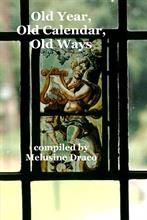
JANUARY: [OE ] Æfterra Gēola ‘After ‘Yule’ or ‘Second Yule’ [OHG]: Wintar-mánód ‘winter month’. The Anglo-Saxons called it Wolfmonath, when wolves moved closer to human habitation to feed off the carcasses of fallen stock. The 14th century misericord country calendar shows it as the time for collecting firewood as the fires would be burning night and day. The tree representing January is the Rowan, a symbol of protection and good luck.
Rowan Magic: The rowan, or mountain ash, is a particularly magical tree – even the Christians adopted its use as a preventative charm against witches! Tie a red ribbon to a berry-bearing branch for general good luck and to keep evil and harm at bay, or make your special wish while you do so. Rowan is also one of the trees believed to take away illness. Take a lock of hair from the sufferer and make a slit in the bark of the tree; push the hair into the slit and as the slit heals, so will the patient. The Saxons made use of this healing property by using a special spoon fashioned from rowan wood to stir medicinal potions.
1st Feast Day of Strenia the old Sabine goddess of good health, and in her name gifts were exchanged for good luck. Small tokens of friendship can be given, but even as late as the early 1900s the old Roman custom of strena was still being observed in rural parts of South Wales, probably having been introduced to Britain by the Romans.
2nd Unluckiest Day. According to the ‘Project Britain Folklore Calendar’ quoting an old Saxon belief, this was one of the unluckiest days of the whole year, and anyone unlucky enough to be born on it could be expected to die an unpleasant death.
4th Hunting The Wren. Although the wren has always enjoyed a certain protection as a sacred bird, on one day of the year it was hunted and killed. The reason why the traditional Midwinter ‘hunting of the wren’ now takes place in early January is because the shift from the Julian to the Gregorian calendar meant eleven days were lost in the process. See 26th December. As an example of transference magic, the wren was expected to shoulder all the ills and problems of the people; effectively taking their bad luck, ill health, and so forth, leaving them free to hope for good health and prosperity in the coming year. Traditionally, the tree of the wren is the ivy, while the robin is allocated the holly. A simple rite from Traditional Witchcraft for Fields & Hedgerows that could be performed instead of the actual killing of a wren.
5th Twelfth Night. Currently the last day of the Christmas season and the night for wassailing and Twelfth Night celebrations; and there can be no doubt that the title of Shakespeare’s play Twelfth-Night took its origin in the festivities with this festival and the proper close of the festivities of Christmas. According to Folk-Lore of Shakespeare, the play was probably originally acted at the barrister’s feast at the Middle Temple on 2nd February [Candlemas] 1602. “It is worthy of note that the festivities at Christmas-tide, were conducted on the most extravagant scale. In addition to the merry disports of the Lord of Misrule, there were various revels. The Christmas masque at Gray’s Inn in 1594 was on a magnificent scale.”
5th The Ashen Faggot is a West Country Christmas custom – it’s a large log with withies bound around it to make a bundle which is burned indoors in the hearth. Drinks are consumed as each withy breaks in the flames, which sounds like an excuse for conviviality!
5th Lars Compitalia, festival of the Roman guardians of the crossroads celebrated with socialising and entertaining.
6th Old Christmas Day is still celebrated in Ireland as Nollaig na mBan, ‘Little Christmas’ or ‘Women’s Christmas’ and is regarded by many as the end of the Christmas season. According to the Julian calendar this is the date of Dies Natalis Solis Invicti and many of the orthodox churches still observe this date. Today: A time to honour the old gods with feasting in the company of friends and to burn a faggot made of the Nine Sacred Woods.
Plough Monday is the traditional start of the English agricultural year and while local customs may vary, Plough Monday is generally the first Monday after Twelfth Day on 6th January. References to Plough Monday date back to the late 15th century, which means the festivities would have coincided with the old Julian calendar. The traditional Norfolk ‘Plough Pudding’ is a boiled suet pudding, containing meat and onions and eaten on Plough Monday.
Hilary Term in the Law Courts, begins on Plough Monday and ends the Wednesday before Easter. It is so called in honour of St Hilary whose feast day in 14th January.
Gaudy Days: Feast days in the Colleges of our Universities are so called, as they were formerly at the Inns of Court. “They were so called, says Blount, ‘from guadium, because, to say truth, they are days of joy, as bringing good cheer to the hungry students”. [Folk-Lore of Shakespeare]
7th St Distaff’s Day This was traditionally when women resumed their household work after the holiday, as Robert Herrick’s bawdy poem, Saint Distaff’s Day; or the Morrow after Twelfth Day describes:
Partly work and partly play
Ye must on St Distaff’s Day;
From the plough soon free your team,
Then come home and fodder them;
If the maids a-spinning go,
Burn the flax and fire the tow;
Scorch their plackets but beware
That ye singe no maiden-hair:
Bring in pails of water then,
Let the maids bewash the men;
Give St Distaff all the right,
Then bid Christmas sporty good-night,
And next morrow every one
To his own vocation.
Weather-lore: ‘If the birds begin to sing in January, Frosts are on the way’.
11th Juturna, Carmentalia and Old New Year’s Eve. Juturna is the Roman goddess of fountains and the underworld whose symbol is a spring; this was an ancient fire festival still celebrated as Old New Year even after the calendar reforms. Today: An opportunity to extend the Yuletide celebrations and see in Old New Year’s Eve.
12th [OS] Handsel Among the rural population of Scotland, Auld Hansel Monday is traditionally celebrated on the first Monday after January 12th, reflecting a reluctance to switch from the old style calendar to the new one. The firm conviction that the special character of Old New Year’s Day was reflected in the natural world held that whoever succeeded in drawing the first water – known as the creame – from any well (spring) would be lucky. Today: Make a trip to your local well – for luck.
13th St Hilary’s Day. This feast day has gained the reputation of being the coldest day of the year due to past cold events starting on or around this date. See Plough Monday.
14th Despite the earlier alterations, by the 21st century the Julian calendar is now thirteen days behind the Gregorian calendar, thus January 14th is sometimes celebrated as New Year’s Day (Old New Year) by the many religious groups who still use the old calendar.
17th Old Twelfth Night. In some places Old Twelfth Night is still celebrated on this evening, continuing the custom on the date determined by the Julian calendar. Today: This really is the time to party according to all the old traditions.
17th Feast day of Felicitas, the Roman personification of good fortune, happiness or felicity. Today: Might be a good time to consult whatever is your method for foretelling the future to make sure there’s nothing nasty lurking in the woodshed!
17th Wassailing the Apple Trees at Carhampton in Somerset where cider is poured on the roots of the finest tree and spiced wassail cake is placed in the branches. Shotguns are fired through the branches to drive away evil spirits to the chant: ‘Hats full, caps full, three bushel bags full’. Another is a seasonal poem by Robert Herrick:
Wassail the trees, that they may bear
You many a plum and many a pear;
For more or less fruits they will bring
As you do give them wassailing.
20th St Agnes Eve. This was the eve on which girls and unmarried woman who wished to dream of future husbands would perform all sorts of rituals (depending on the part of the country they lived) before going to bed.
21st Agnes Day According to Aubrey’s Miscellany: ‘Upon St Agnes night, you take a row of pins, and pull out everyone, one after another. Saying a pater-noster, stick a pin in your sleeve, and you will dream of him or her you shall marry.’ A Scottish version of the ritual would involve young women meeting together on St. Agnes’s Eve at midnight, they would go one by one, into a remote field and throw in some grain, after which they repeated the following rhyme in a prayer to St. Agnes: “Agnes sweet, and Agnes fair, Hither, hither, now repair; Bonny Agnes, let me see The lad who is to marry me.”
Weather-lore: If on St Vincent Day (22nd) the sky is clear, More wine than water will crown the year. Or on St Paul’s Day (23rd) the rural prophecy claimed that if the day was fine there would be a good harvest; if rain or snow, scarcity and famine. Clouds and mist signified pestilence, and high winds, war.
Old Year, Old Calendar, Old Ways compiled by Melusine Draco is published by Ignotus Press UK and available at a special price direct from the publishers
https://www.feedaread.com/books/Old-Year-Old-Calendar-Old-Ways-9781788762052.aspx





 RSS Feed
RSS Feed